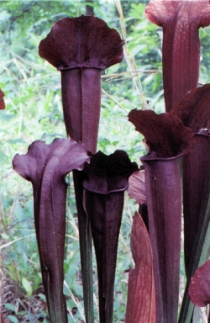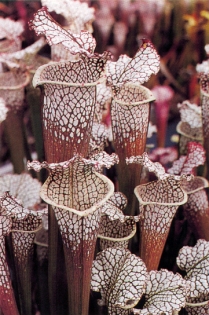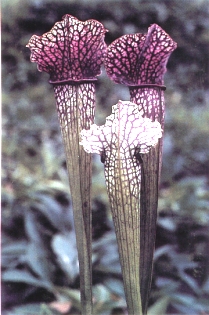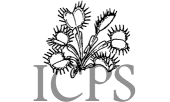|
Carnivorous Plant Newsletter
Volume 31, Number 2, June 2002, pages 40 - 43
NEW CULTIVARS
Sarracenia ‘Tornado’
Sarracenia leucophylla ‘Cronus’
Sarracenia ‘Fireworks’
Sarracenia ‘Tornado’
Received: 21 December 2001
Sarracenia ‘Tornado’ was created in May 1983 by crossing a very
dark red (black-red) form of S. alata with an maternal parent hybrid
developed at Botanique nursery. The maternal parent is a deep red,
velvety-textured hybrid selection of S. (leucophylla x purpurea)
x S. alata (the S. alata in this cross is also a dark red clone).
Thus, the derivation of S. ‘Tornado’ is: S. ((leucophylla x purpurea) x alata) x alata. I performed the pollination in hopes
of improving the shape and vigor of the maternal parent, which has
a huge open mouth that is prone to rain damage. The overarching
lid character of S. alata successfully was transferred to several
selections from this cross, one of which is S. ‘Tornado’,
selected and named in November of 1989.
S. ‘Tornado’ pitchers emerge green, flushed with red
and red veins and showing white and pink spots. The pitchers quickly
become nearly black-red, without the irregular coloration problems
found in many S. alata clones. The upper one half to two thirds
of each pitcher matures essentially all black-red without noticeable
contrasting venation. The dark red color mixes with green in the
lower section, then quickly becomes nearly all green at the bottom
of the leaf. Many pitchers are produced throughout the season, each
being somewhat flattened, along the front to rear centerlines. This
creates an oval cross section, near the mouth. Mature pitcher height
is about 61-66 cm (24-26 inches). A dark red lid covers the wide,
slightly pouched pitchers and inhibits rain entry and breakage;
this lid is usually reniform and can reach 9 cm (3.5 inches) across
on taller pitchers.
Flower petals are pink. However, only one flower has been observed
so far, due to several late-season frosts which damaged developing
buds. The one flower was not particularly noteworthy, but future
flowers will be examined to present a more detailed description.
Because of the unique color and complex parentage, this hybrid
must be vegetatively propagated. Botanique plans on putting S. ‘Tornado’
into tissue culture as soon as possible.
Plants of this cultivar are sold under the trade-mark Sarracenia ‘Vortex’™
ROB SACILOTTO • Stanardsville, VA • USA

Figure 1. Sarracenia 'Tornado'
Sarracenia leucophylla ‘Cronus’
Received: 21 December 2001
Sarracenia
leucophylla ‘Cronus’ was selected from numerous
seedlings resulting from crossing plants originally from Seminole
Co., FL with plants originally from Baldwin Co., AL. I performed
this pollination during May 1981 in Greene County, Virginia. By
crossing from two different population areas, I hoped to achieve
some plants with increased vigor. Reemay (R) bags were used to regulate
pollination. In November of 1985, the largest of the seedlings from
the above breeding was named Sarracenia ‘Cronus’
for its unusually large size and vigorous growth. Botanique first
offered this cultivar for sale in January of 2001, two years after
having established it in tissue culture. The first public offering
appeared in the Botanique web site (http://www.pitcherplant.com)
where a color image also appeared.
Sarracenia leucophylla ‘Cronus’ has produced
fall pitchers over 96.5 cm (38 inches) tall. The mouth typically
is 6-9 cm (2 1/2--3 1/2 inches) across. The upper pitcher shows
more white than many forms of S. leucophylla, with deep
red veins dividing the white background. The rim of the mouth is
white, with reddish marbling. Because the lid is adequately large
and angled over the mouth, rain is less likely to damage the pitchers
than it may with many open mouthed forms of Sarracenia.
Despite the very dramatic pitchers, the flowers are not significantly
different from the wild forms, being medium red and about 6.3-7.6
cm (2 1/2-3 inches) across and in height (sepal to distal tip of
petal). The flower stem is a bit shorter than normal, typically
reaching 25-36 cm (10-14 inches). We have observed that this plant
is not a good seed producer (often, few or no seeds form in the
pods). In order to maintain the complex characteristics of this
cultivar, vegetative propagation is needed to multiply it.
We have observed this cultivar to grow faster than most other Sarracenia,
when shifting from tissue culture (flasks or test tubes) to marketable
size (approximately a 3.8 liter (one gallon) pot). Due to quick
size increase, it is recommended that S. leucophylla ‘Cronus’
be planted in containers or gardens at least 30 cm (12 inches) deep
and spaced at least 41 cm (16 inches) from other plants. In plantings
with other S. leucophylla types, S. leucophylla
‘Cronus’ has consistently grown larger than these other
types, in identical situations. As with most S. leucophylla,
the largest and showiest pitchers are produced in late summer to
fall.
Plants of this cultivar are sold under the trade-mark Sarracenia
‘Titan’™
ROB SACILOTTO • Stanardsville, VA • USA

Figure 2. Sarracenia leucophylla 'Cronus'
Sarracenia ‘Fireworks’
Received: 21 December 2001
Sarracenia ‘Fireworks’ was one of the hybrids I created by crossing
a female S. rubra subsp. jonesii x purpurea with pollen from a heavily
red-pigmented form of S. leucophylla. The pollination was performed
in May of 1977, with seed produced that same fall. Pollination was
controlled using Reemay® bags to prevent random outcrossing.
The seed was germinated in the George Mason University greenhouse,
Fairfax County, VA, in late December of 1977. These seedlings were
not given a dormancy until worthy seedlings were identified in 1979,
1980 and 1982. I am evaluating other plants from this breeding and
hope to register additional selections in the future.
I named S. ‘Fireworks’ in May of 1979. At an early
age, this hybrid displayed many desirable qualities in the pitchers,
and was selected for further evaluation and retention in my collection.
As the plant matured, its features became more apparent, and the
first flowers appeared in 1983. By this time, the plant had been
transferred to Botanique, in Greene County, VA. Here, many divisions
were eventually made. After establishing the plant in tissue culture,
divisions were offered for sale in March of 2000. Plants were also
sold in early 2001. An image of the pitcher and flower was posted
in the Botanique web site (http://www.pitcherplant.com) on March
of 2000.
The pitchers are usually 15.2--25.4 cm (6--10 inches) tall, with
a ruffled lid. The lower half of the pitchers are green with red
veins. The upper portion is mostly white, with deep maroon veins.
The lip is usually deep maroon. A maroon flushing, on the inner
ala and lid, is most intense near the mouth, and fades to white
with red veins toward the distal portion of the inner lid. Red pigments
are most vibrant in mid to late summer. The widest point of the
pitcher, excluding the lid, typically ranges about 2.5--4 cm (1--1
1/2 inches).
S. ‘Fireworks’ performs well in the garden by producing
many pitchers throughout the growing season. The lid is angled to
assist in keeping rain out of the pitchers. Flower color is a deep
burgundy red, without noticeable odor. These appear above developing
foliage on strong stems, averaging 31--36 cm (12--14 inches) tall.
The influence of S. rubra subsp. jonesii is apparent not only in
the flower color, but in the growth habit of making many crowns
in a short time. The many crowns, or “leads,” create
a foundation for a beautifully lush display of flowers and pitchers.
Pitchers and flowers often appear simultaneously, especially on
established plants. Phyllodia (flat leaves) are rarely produced.
This hybrid must be propagated vegetatively in order to maintain
its complex characteristics.
Plants of this cultivar are sold under the trade-mark Sarracenia ‘White Sparkler’™
ROB SACILOTTO • Stanardsville, VA • USA

Figure 3. Sarracenia 'Fireworks'
|

